

The following brief notes cover all the locks on the River Thames and start at the lock nearest the head of the River - St. John's at Lechlade. Distances are given in statute miles and kilometres above or below the Boundary Stone at Teddington which marks the boundary between the navigation responsibilities of the Environment Agency (EA) and the Port of London Authority (PLA). The stone is situated 0.24 miles (0.36 km) below Teddington Lock.
The Environment Agency and its predcessors, the National Rivers Authority, the Thames Water Authority and the Thames Conservancy, have each had an annual programme of maintenance and repair. The extent of works carried out at the locks has, over the years, been extensive and varied but only the most significant works are mentioned below.
ST. JOHN'S LOCK
The first pound lock was built of stone in 1790 by J Nock for the Thames Navigation Commissioners. The first lock keeper's house was built in 1830. The lock was repaired in 1867 and both the lock and house were rebuilt by the Thames Conservancy in 1905. This lock, along with those downstream as far as King's, is still manually operated. |
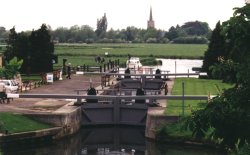 |
St. John's Lock |
Length |
Width |
Fall |
Distance above Teddington |
Telephone Number |
110'3" (33.60 m) |
14'10" (4.52 m) |
2'10" (0.85 m) |
123.45 (198.67) |
01367 252309 |
BUSCOT LOCK
 |
The first pound lock dates from 1790 when a stone lock was built for the Thames Navigation Commissioners. The first lock keeper's house was built in 1791. New gates to the lock were fitted by the Thames Conservancy in 1867. A new weir and channel was constructed by Thames Water Authority in 1979. |
Buscot Lock |
Length |
Width |
Fall |
Distance above Teddington |
Telephone Number |
109'10" (33.47 m) |
14'8" (4.47 m) |
6'6" (1.69 m) |
122.30 (196.82) |
01337 252434 |
GRAFTON LOCK
The first pound lock was built in 1896 by the Thames Conservancy to replace a flash lock known as Hart's Weir. |
 |
Grafton Lock |
Length |
Width |
Fall |
Distance above Teddington |
Telephone Number |
113'6" (34.59 m) |
15'1" (4.59 m) |
3'8" (1.11 m) |
118.96 (191.45) |
01367 810251 |
RADCOT LOCK
 |
The first pound lock was built in 1892 by the Thames Conservancy to replace a flash lock known as either Clarke's, Beck's or Buck's. |
Radcot Lock |
Length |
Width |
Fall |
Distance above Teddington |
Telephone Number |
113'6" (34.59 m) |
15'0" (4.57 m) |
4'10" (1.48 m) |
117.11 (188.47) |
01367 240676 |
RUSHEY LOCK
The first pound lock was built of stone in 1790 for the Thames Navigation Commissioners. It was repaired in 1867 and then rebuilt by the Thames Conservancy in 1898. |
 |
Rushey Lock |
Length |
Width |
Fall |
Distance above Teddington |
Telephone Number |
113'6" (34.59 m) |
15'1" (4.59 m) |
6'0" (0.82 m) |
114.48 (184.24) |
01367 870218 |
SHIFFORD LOCK
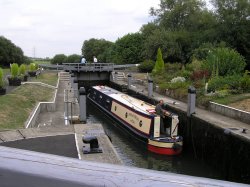 |
The first pound lock was built in 1898 by the Thames Conservancy to replace a flash lock which appears to have been about 3/4 mile below this new location. |
Shifford Lock |
Length |
Width |
Fall |
Distance above Teddington |
Telephone Number |
113'8" (34.64 m) |
15'1" (4.59 m) |
7'4" (2.23 m) |
110.18 (177.32) |
01367 870247 |
NORTHMOOR LOCK
The first pound lock was built in 1896 by the Thames Conservancy to replace a flash lock known as Rudge's or Hart's situated about 1 mile upstream of this location. The current lock keeper's house was also built in 1836. Not only is this lock still operated manually but its associated weir is one of only three weirs on the Thames that are still operated using only paddlers and rymers. |
 |
Northmoor Lock |
Length |
Width |
Fall |
Distance above Teddington |
Telephone Number |
113'6" (34.59 m) |
15'1" (4.59 m0 |
4'1" (1.24 m) |
105.44 (169.69) |
01865 862923 |
PINKHILL LOCK
 |
The first pound lock was built of stone in 1791 for the Thames Navigation Commissioners. A new lock was built by the Thames Conservancy in 1898. The current lock keeper's house dates from 1932. There is a public footpath crossing over the lower gates. |
Pinkhill Lock |
Length |
Width |
Fall |
Distance above Teddington |
Telephone Number |
113'6" (34.59 m) |
16'1" (4.90 m) |
3'6" (1.05 m) |
101.58 (163.48) |
01865 881452 |
EYNSHAM LOCK
In 1886 a new flash weir was built and this was not replaced until 1928 when a new concrete pound lock was built by the Thame Conservancy. In 1950 the entire weir was reconstructed. |
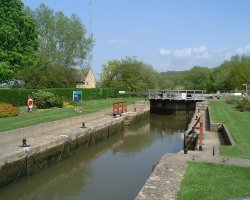 |
Eynsham Lock |
Length |
Width |
Fall |
Distance above Teddington |
Telephone Number |
113'3" (34.51 m) |
16'4" (4.97 m) |
2'9" (0.84 m) |
100.10 (161.10) |
01865 881324 |
KING'S LOCK
 |
The flash lock was rebuilt and enlarged in 1885 but the first pound lock, which was constructed using concrete, was not built until 1928 by the Thames Conservancy despite the fact that in 1817 it was considered that a pound lock was desirable and that it would be built as soon as funds became available. |
King's Lock |
Length |
Width |
Fall |
Distance above Teddington |
Telephone Number |
113'1" (34.46 m) |
16'4" (4.97 m) |
2'6" (0.77 m) |
97.39 (156.73) |
01865 553403 |
GODSTOW LOCK
Godstow lock was built of stone by the Thames Navigation Commissioners in 1790. The Thames Conservancy rebuilt the lock using concrete and steel piling in 1924. It was the last lock on the Thames to be mechanised. All the locks above Godstow are still manually operated. |
 |
Godstow Lock |
Length |
Width |
Fall |
Distance above Teddington |
Telephone Number |
110'0" (33.52 m) |
16'3" (4.95 m) |
5'2" (1.57 m) |
96.26 (161.10) |
01865 445784 |
OSNEY LOCK
 |
The first pound lock at Osney was built of stone by the Thames Navigation Commissioners in 1790. It was rebuilt by the Thames Conservancy in 1905. |
Osney Lock |
Length |
Width |
Fall |
Distance above Teddington |
Telephone Number |
113'8" (34.64 m) |
17'3" (5.25 m) |
6'3" (1.89 m) |
93.86 (151.05) |
01865 247050 |
IFFLEY LOCK
The Lock at Iffley was one of the first pound locks to be built on the Thames. It was one of three built by the Oxford - Burford Commission in around 1631. The Thames Navigation Commissioners rebuilt it in 1793. The first lock keepers house was not built until 1810. The lock was lengthened by the Commissioners in both 1802 and 1806 and repaired by the Thames Conservancy in 1866 who later rebuilt it in 1927. |
 |
Iffley Lock |
Length |
Width |
Fall |
Distance above Teddington |
Telephone Number |
154'1" (46.96 m) |
21'3" (6.47 m) |
2'9" (0.84 m) |
91.54 (147.32) |
01865 777277 |
SANDFORD LOCK
 |
This was also one three locks built by the Oxford - Burford Commission in around 1631. It was rebuilt by the the Thames Navigation Commissioners in 1794/5. The Commissioners then built a new lock in 1836 adjacent to the original lock. The first lock keepers house followed in 1839. The lock was reconstructed in 1972/3 by the Thames Conservancy in their last year of the management of the River Thames. It was the first of a series of locks built with an underfloor filling system. At 8'10" (2.69 metres), the fall on this lock is the largest on the Thames. |
Sandford Lock |
Length |
Width |
Fall |
Distance above Teddington |
Telephone Number |
174'0" (53.03 m) |
21'9" (6.62 m) |
8'10" (2.69 m) |
89.86 (144.62) |
01865 775889 |
ABINGDON LOCK
The first pound lock in Abingdon town was built by the Thames Navigation Commissioners in 1790. An earlier lock was built on the Swift Ditch, a little way upstream, by the Oxford - Burford Commission in around 1635 when the Swift Ditch was the main navigation channel. The Thames Conservancy rebuilt Abingdon lock in 1905. |
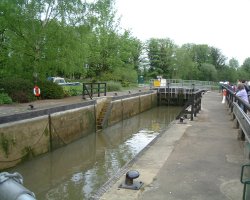 |
Abingdon Lock |
Length |
Width |
Fall |
Distance above Teddington |
Telephone Number |
120'0" (36.57 m) |
18'9" (5.71 m) |
6'2" (1.89 m) |
85.28 (137.24) |
01235 523044 |
CULHAM LOCK
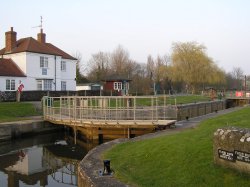 |
The first pound lock was built in stone by the Thames Navigation Commission in 1809. The current lock keepers house was built in 1957. |
Culham Lock |
Length |
Width |
Fall |
Distance above Teddington |
Telephone Number |
130'10" (39.87 m) |
17'6" (5.33 m) |
7'11" (2.41 m) |
82.70 (133.09) |
01235 522061 |
CLIFTON LOCK
A lock was first muted in this location in 1793 and again in 1811 but it was not until 1822 that the Thames Navigation Commissioners finally built it. When they did they made a new cut that by-passed the loop in the River at Long Wittenham. There were no earlier locks at this site. |
 |
Clifton Lock |
Length |
Width |
Fall |
Distance above Teddington |
Telephone Number |
129'10" (39.57 m) |
19'0" (5.79 m) |
3'5" (1.03 m) |
79.89 (128.57) |
01865 407821 |
DAY'S LOCK
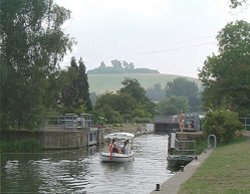 |
The Thames Navigation Commissioner built the first pound lock here in 1789. It was open-sided and built in oak.The Thames Conservancy rebuilt it in 1871 and then again in 1925. A new lock keepers house was built two years earlier in 1923. |
Day's Lock |
Length |
Width |
Fall |
Distance above Teddington |
Telephone Number |
154'10" (46.93 m) |
21'2" (6.45 m) |
5'2" (1.58 m) |
76.91 (123.77) |
01865 407768 |
BENSON LOCK
The first pound lock on this site was open sided and made of oak. It was built in 1788 by the Thames Navigation Commissioners. The Thames Conservancy rebuilt it in 1870. The current lock keepers house was built in 1913. There is a public footpath over the tail gates and adjacent weir. |
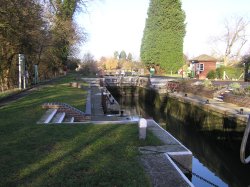 |
Benson Lock |
Length |
Width |
Fall |
Distance above Teddington |
Telephone Number |
133'1" (40.56 m) |
17'11" (5.46 m) |
6'2" (1.03 m) |
73.95 (117.40) |
01491 835255 |
CLEEVE LOCK
 |
The Thames Navigation Commissioners built the first pound lock here in 1787. It was open-sided and built in oak.The Thames Conservancy rebuilt it in 1874. |
Cleeve Lock |
Length |
Width |
Fall |
Distance above Teddington |
Telephone Number |
133'7" (40.71 m) |
18'2" (5.53 m) |
2'3" (0.69 m) |
66.45 (106.94) |
01491 872608 |
GORING LOCK
The Thames Navigation Commissioners built the first pound lock here in 1787. It was built of oak and had closed sides. The first lock keepers house was built in 1879. The lock was rebuilt by the Thames Conservancy in 1886 and again in 1921 when, because of its increased length, it was built with a pair of intermediate gates making two chambers. The Environment Agency refurbished the lock in 2003 when the intermediate gates were removed. |
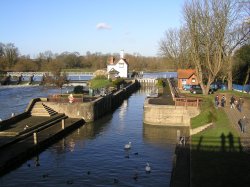 |
Goring Lock |
Length |
Width |
Fall |
Distance above Teddington |
Telephone Number |
179'5" (54.68 m) |
21'0" (6.40 m) |
5'10" (1.77 m) |
65.83 (105.94) |
01491 872687 |
WHITCHURCH LOCK
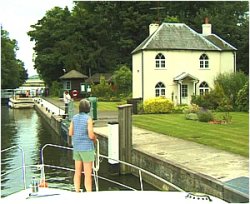 |
The Thames Navigation Commissioners built the first pound lock here in 1787 with the first house being built in 1829. The lock was open-sided and built in oak.The Thames Conservancy rebuilt it in 1876. Whitchurch is the only lock on the Thames that hasn't got public access except by boat as the access from Whitchurch Village was stopped up in 1888. |
Whitchurch Lock |
Length |
Width |
Fall |
Distance above Teddington |
Telephone Number |
135'3" (41.22 m) |
18'0" (5.48 m) |
3'4" (1.01 m) |
61.76 (99.39) |
0118 984 2448 |
MAPLEDURHAM LOCK
The first pound lock here was built of fir in 1778 by the Thames Navigation Commissioners. The Thames Conservancy rebuilt it in 1867 and again in 1908 when it was greatly enlarged. In 1955/6 it had electro-mechanical gear installed which made it the first power operated lock on the Thames. It was converted to the more reliable hydraulic system in 1973. The current lock keeper's house dates from 1931. |
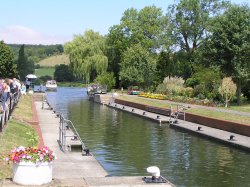 |
Mapledurham Lock |
Length |
Width |
Fall |
Distance above Teddington |
Telephone Number |
202'5" (61.69 m) |
21'1" (6.42 m) |
6'9" (2.05 m) |
59.48 (95.72) |
0118 941 7776 |
CAVERSHAM LOCK
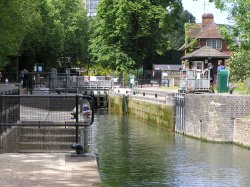 |
The Thames Navigation Commissioners built the first pound lock here in 1778. It was built of fir. The Thames Conservancy rebuilt it in 1875. There is a public footpath across the head gates and across the adjacent weir. The current lock keepers house was built in 1931. |
Caversham Lock |
Length |
Width |
Fall |
Distance above Teddington |
Telephone Number |
131'4" (40.03 m) |
17'11" (5.46 m) |
4'9" (1.44 m) |
55.08 (88.64) |
0118 957 5764 |
SONNING LOCK
The first pound lock here had open sides and was built of fir in 1773 by the Thames Navigation Commissioners but was rebuilt soon after in oak (1787). The first lock keepers house was built of timber in 1774. The Thames Conservancy rebuilt the lock in 1868 and again in 1905 and a new house was built in 1916. The current house was built in 1925. During the winter of 2004/5, the existing pre-1970's wooden gates were replaced with new steel gates. In addition, a new operating system was installed allowing the public to have power available at a slower speed when using the lock ouside normal operating hours. If successful, this new system will be fitted to new lock gate replacement schemes in the future and, as funds become available, retrofitted to existing hydraulic systems. |
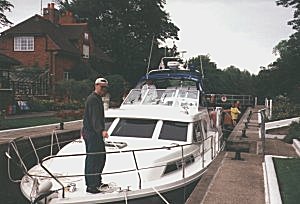 |
Sonning Lock |
Length |
Width |
Fall |
Distance above Teddington |
Telephone Number |
156'1" (47.57 m) |
17'11" (5.46 m) |
5'4" (1.63 m) |
52.45 (84.41) |
0118 969 3992 |
SHIPLAKE LOCK
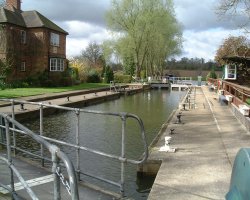 |
The first pound lock at Shiplake was built of fir in 1773 by the Thames Navigation Commissioners but was rebuilt in oak in 1787. The Thames Conservancy rebuilt the lock in 1874. In 1960/1 it was the first lock on the Thames to have the hydraulic system of operation installed. |
Shiplake Lock |
Length |
Width |
Fall |
Distance above Teddington |
Telephone Number |
133'4" (40.64 m) |
18'3" (5.56 m) |
5'1" (1.55 m) |
49.54 (79.73) |
0118 940 3350 |
MARSH LOCK
The first pound lock at Marsh had closed sides and was built of fir in 1773 by the Thames Navigation Commissioners but was rebuilt in oak in 1787. The first lock keepers house was built in 1813. The Thames Conservancy rebuilt the lock in 1886 and again in 1914. Public access to the lock is via an adjacent footbridge across the weir. |
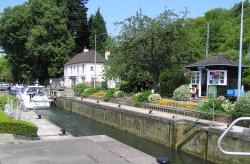 |
Marsh Lock |
Length |
Width |
Fall |
Distance above Teddington |
Telephone Number |
135'2" (41.19 m) |
21'1" (6.42 m) |
4'4" (1.33 m) |
46.56 (74.93) |
01491 572992 |
HAMBLEDEN LOCK
 |
There is a possibility that a 'Flash' lock existed on this site as early as 1338 but the first pound lock at Hambleden was open sided and built of timber in 1773 by the Thames Navigation Commissioners. The first lock keepers house was of timber construction and built in 1774 but it was rebuilt in brick in 1777. The current house dates from 1928. The Thames Conservancy rebuilt the lock in 1873. In 1993/4 a new enlarged lock was built by the National Rivers Authority and it was the first lock on the Thames to have all steel gates. There is a public footpath over the tail gates and adjacent weir. The current house was built in 1925. This is one of the locks on the Thames that has power available when the lock is being operated by the public outside normal opening hours. |
Hambleden Lock |
Length |
Width |
Fall |
Distance above Teddington |
Telephone Number |
198'3" (61.00 m) |
25'0" (7.70 m) |
4'9" (1.44 m) |
43.71 (70.34) |
01491 571269 |
HURLEY LOCK
The first pound lock at Hurley had open sides and was built of fir in 1773 by the Thames Navigation Commissioners. A wooden lock keeper's house was built in 1774. The lock was rebuilt in brick in 1785. Sides were added to the lock in 1825. |
 |
Hurley Lock |
Length |
Width |
Fall |
Distance above Teddington |
Telephone Number |
130'8" (39.82 m) |
19'11" (6.42 m) |
3'5" (1.05 m) |
40.05 (64.45) |
01628 824334 |
TEMPLE LOCK
 |
The first pound lock on this site was built by the Thames Navigation Commissioners in 1773 with the first lock keepers house being built in 1777. The lock was rebuilt in 1782. In 1890 a new lock was built alongside the old pound but this time by the Thames Conservancy. |
Temple Lock |
Length |
Width |
Fall |
Distance above Teddington |
Telephone Number |
134'7" (41.02 m) |
17'11" (5.46 m) |
4'1" (1.23 m) |
39.41 (63.42) |
01628 824333 |
MARLOW LOCK
The first pound lock at Marlow had closed sides and was built of fir in 1773 by the Thames Navigation Commissioners but was rebuilt in stone in 1825. The first lock keepers house was built in 1815. The Thames Conservancy rebuilt the lock in 1927. |
 |
Marlow Lock |
Length |
Width |
Fall |
Distance above Teddington |
Telephone Number |
151'3" (46.10 m) |
19'11" (6.07 m) |
7'1" (2.16 m) |
37.46 (60.29) |
01628 482867 |
COOKHAM LOCK
 |
The Thames Navigation Commissioners built the first lock on this site in 1830. It was lengthened by the Thames Conservancy in 1892 and then totally rebuilt by them in 1956/7 when electric controls were added. It was also built with intermediate gates. It was changed to hydraulic control in 1974 by the Thames Water Authority in their first year of managing the River Thames. |
Cookham Lock |
Length |
Width |
Fall |
Distance above Teddington |
Telephone Number |
183'0" (55.77 m) |
25'0" (7.62 m) |
4'3" (1.30 m) |
33.46 (54.29) |
01628 520752 |
BOULTERS LOCK
The first lock at Boulters was built by the Thames Navigation Commissioners in 1772 with the first lock keepers house being built of timber two years later in 1774. It was rebuilt on a new site in 1829 (the site of the current lock). The Thames Conservancy built a new lock in 1868 which they rebuilt in 1912. The current house was built in 1925. This is one of the locks on the Thames that has power available when the lock is being operated by the public outside normal opening hours. |
 |
Boulter's Lock |
Length |
Width |
Fall |
Distance above Teddington |
Telephone Number |
199'6" (60.80 m) |
21'3" (6.47 m) |
7'10" (2.39 m) |
31.38 (50.50) |
01826 624205 |
BRAY LOCK
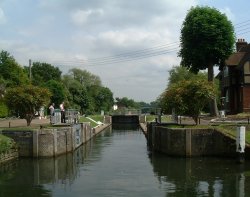 |
The Thames Navigation Commissioners were responsible for building the first pound lock at Bray in 1845. It had open sides. Most unusually they built the lock keepers house in 1844 one year before the lock was built. Sides were added to the lock in 1857. The Thames Conservancy rebuilt the lock on a new site in 1888. The current lock keepers house dates from 1911. |
Bray Lock |
Length |
Width |
Fall |
Distance above Teddington |
Telephone Number |
134'4" (40.94 m) |
17'11" (5.46 m) |
4'9" (1.46 m) |
29.25 (47.07) |
01826 621650 |
BOVENEY LOCK
The first pound lock on this site was built by the Thames Navigation Commissioners in 1838. A new lock was subsequently built by the Thames Conservancy in 1898 alongside the old pound. |
 |
Boveney Lock |
Length |
Width |
Fall |
Distance above Teddington |
Telephone Number |
149'7" (45.59 m) |
17'10" (5.43 m) |
4'10" (1.47 m) |
26.08 (41.97) |
01753 862764 |
ROMNEY LOCK
 |
The first pound lock was built by the Thames Navigation Commissioners in 1798. It was built of oak. The lock was rebuilt by the Thames Conservancy in 1869. When it was rebuilt again by the Thames Water Authority in 1979/80, a new type of underfloor filling arrangement was used. The current house was built in 1925. This is one of the locks on the Thames that has power available when the lock is being operated by the public outside normal opening hours. |
Romney Lock |
Length |
Width |
Fall |
Distance above Teddington |
Telephone Number |
134'4" (40.94 m) |
17'11" (5.46 m) |
4'9" (1.46 m) |
23.15 (37.07) |
01826 621650 |
OLD WINDSOR LOCK
The Thames Navigation Commissioners built the first pound lock here in 1822. It was rebuilt by the Thames Conservancy in 1889 and again in 1957 when it was constructed of pre-stressed concrete. It was also built with electric controls but these were changed to a hydraulic system in 1965. The current lock keepers house was built in 1930. This is one of the locks on the Thames that has power available for the public to use when they are operating the lock outside normal opening hours. |
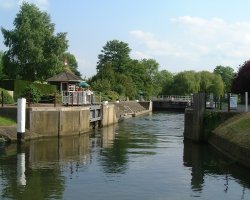 |
Old Windsor Lock |
Length |
Width |
Fall |
Distance above Teddington |
Telephone Number |
179'0" (54.55 m) |
24'2" (7.36 m) |
5'9" (1.74 m) |
20.75 (33.39) |
01753 861822 |
BELL WEIR LOCK
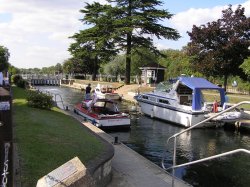 |
The first pound lock was built by the Thames Navigation Commissioners in 1817/8. The lock was rebuilt in stone by the Thames Conservancy in 1867. It was rebuilt again in 1973/4 with an underfloor filling arrangement although traditionasl sluices were kept in the tail gate. The current house was built in 1959. This is one of the locks on the Thames that has power available when the lock is being operated by the public outside normal opening hours. |
Bell Weir Lock |
Length |
Width |
Fall |
Distance above Teddington |
Telephone Number |
257'7" (78.51 m) |
24'5" (7.44 m) |
6'0" (1.82 m) |
17.83 (28.69) |
01784 432333 |
PENTON HOOK LOCK
This lock was built by the Corporation of the City of London in 1815. It was rebuilt by the Thames Conservancy in 1875 and enlarged and rebuilt again by them in 1909. This is one of the locks on the Thames that has public power available when the lock is being operated outside normal opening hours. |
 |
Penton Hook Lock |
Length |
Width |
Fall |
Distance above Teddington |
Telephone Number |
266'8" (81.28 m) |
24'10" (7.56 m) |
4'0" (1.22 m) |
14.99 (24.12) |
01784 452657 |
CHERTSEY LOCK
 |
This lock was built by the Corporation of the City of London in 1813. It was rebuilt by the Thames Conservancy in 1866 and again in 1913 when it was enlarged. This is one of the locks on the Thames that has public power available when the lock is being operated outside normal opening hours. |
Chertsey Lock |
Length |
Width |
Fall |
Distance above Teddington |
Telephone Number |
200'8" (61.16 m) |
21'0" (6.40 m) |
4'0" (1.22 m) |
13.04 (20.99) |
01932 562208 |
SHEPPERTON LOCK
The Corporation of the City of London built the first pound lock here in 1813 but in 1825 it had to be extensively repaired and in 1829 it was enlarged. A new lock was built by the Thames Conservancy in 1899 which was mechanised by them in 1963. This is one of the locks on the Thames that has public power available when the lock is being operated outside normal opening hours. |
 |
Shepperton Lock |
Length |
Width |
Fall |
Distance above Teddington |
Telephone Number |
174'5" (53.16 m) |
19'10" (6.04 m) |
6'8" (2.03 m) |
10.98 (17.67) |
01932 221840 |
SUNBURY LOCKS
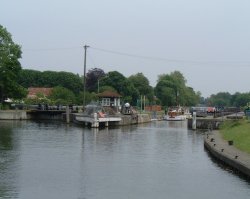 |
The Corporation of the City of London built the first pound lock here in 1812 with the first lock keepers house being built one year later in 1813. Both the lock and house were rebuilt by them in 1856. The Thames Conservancy built a new lock alongside the original in 1925/6 and both locks are still in existance today. The newer lock has been fully mechanised and is one of the locks on the Thames that has public power available when the lock is being operated outside normal opening hours. |
Sunbury Locks |
Length |
Width |
Fall |
Distance above Teddington |
Telephone Number |
Old Lock 154'8" (47.15 m) |
19'3" (5.86 m) |
6'2" (1.87 m) |
8.03 (12.92) |
01932 782089 |
New Lock 206'0" (62.78 m) |
24'4" (7.41 m) |
6'2" (1.87 m) |
8.03 (12.92) |
01932 782089 |
MOLESEY LOCK
The Corporation of the City of London built the first pound lock entirely of timber here in 1815 along with the lock keepers house. In 1906 it had to be rebuilt and enlarged by the Thames Conservancy. The current house was built in 1925. This is one of the locks on the Thames that has power available when the lock is being operated by the public outside normal opening hours. |
 |
Molesey Lock |
Length |
Width |
Fall |
Distance above Teddington |
Telephone Number |
268'4" (81.78 m) |
24'10" (7.56 m) |
6'1" (1.85 m) |
5.05 (8.13) |
0208 979 4482 |
TEDDINGTON LOCKS
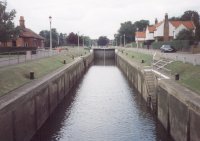 |
The Teddington Launch lock (the centre one of three current locks) was first built in timber by the Corporation of the City of London in 1811 but it had to be extensively repaired in 1825. It was rebuilt in stone by the Thames Conservancy in 1858 when they also constructed the Skiff Lock. The Barge Lock was built in 1904, also by the Thames Conservancy. In 1953 flood lighting and electric signals to control river traffic was installed in 1953. All three locks remain in operation today. The locks at Teddington are manned 24 hours a day. |
The Barge Lock at Teddington |
Length |
Width |
Fall at |
Distance above Teddington |
Telephone Number |
|
Launch Lock |
177'11" (54.22 m) |
24'4" (7.41 m) |
8'10" (2.68 m) |
0.24 (0.39) |
0208 940 8723 |
Barge Lock |
650'0" (198.12 m) |
24'9" (7.54 m) |
8'10" (2.68 m) |
0.24 (0.39) |
0208 940 8723 |
Skiff Lock |
49'6" (15.08 m) |
5'10" (1.77 m) |
8'10" (2.68 m) |
0.24 (0.39) |
0208 940 8723 |
RICHMOND LOCK AND WEIR
The Richmond lock and weir complex was built in 1894 by the Thames Conservancy to maintain a navigable depth of water upstream of Richmond. Except for the period of two hours either side of high water, overhead sluices are lowered into the River from the roof of the footbridge (one in each of the 3 centre archs spanning the River) to form a weir. This then ensures that there is always at least a 1.72m depth of water in the River between Richmond and Teddington. |
 |
Richmond Lock |
When the sluices are in their lowered position the spans are closed to navigation and boats have to use this lock which is on the Surrey bank. Responsibility for the lock and weir passed to the Port of London Authority (PLA) when it commenced its duties in 1909. The lock and weir are are still operated by the PLA. Until fairly recently there was a charge of £5.00 to use the lock but it is now free. This lock is arrangement known as a 'half tide' lock.
Length |
Width |
Fall at |
Distance below Teddington |
Telephone Number |
250'0" (79.20 m) |
26'8" (8.14 m) |
10'0" (3.05 m) |
2.50 (4.63) |
0208 940 0643 |
BLAKE'S LOCK
 |
Although this lock is not on the River Thames (it is on the River Kennet at Reading) it is included here for completeness as this part of the Kennet falls under their jurisdiction of the Environment Agency which owns and operates the lock. |
Blake's Lock |
Length |
Width |
Fall |
Distance above Teddington |
Telephone Number |
122'8" (37.39 m) |
18'11" (5.75 m) |
3'6" (1.07 m) |
Junction of Rivers Kennet and Thames |
0118 957 2251 |
The River Thames - Lock Statistics. |
|
The River Thames - Planned Lock Closures 2004-2005. |
|
To return to The River Thames page. |
|
We do hope you enjoy reading our pages as much as we've enjoyed writing them. If you would like to make any comments or need any further information then please e-mail us, we'd love to hear from you. |
|
|
Copyright İThe Harts